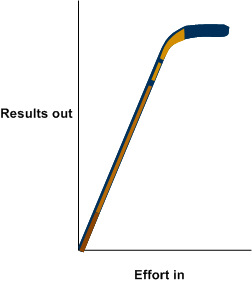The Hockey Stick Curve
One of the repeating patterns in the universe is the law of diminishing returns, and its graphic representation looks like a hockey stick. For a given change in an independent variable—in the case at hand, effort expended—there is initially a sharp increase in the dependent variable—results output. Then, all of a sudden, the curve flattens out. Essentially, you reach a point where additional effort does not give proportionately greater results. The point at which the curve flattens out is the knee.

This brings us to the central theme of this column: In times of tight resources, you must make sure that you commit resources—such as headcount, tools, training, and time—on the steep part of the hockey stick curve. Once you hit the knee, don’t put any additional resources, including your individual time and effort, on a project. Put them somewhere else instead.
In the rest of this column, I’ll examine what are the independent variables writers can control, and how they can manage compromises on those variables.
The Independent Variables
The independent variables most writers have some degree of control over are scope and quality. To our credit, these are two areas in which technical communicators are reluctant to make compromises. The bad news, however, is that when resources are tight, these areas inevitably get compromised. The only question is: Will the compromise be a managed one or an unintended one?
A managed compromise is one where something gets left undone, because you made a rational decision to leave it undone. An unintended compromise is one where something gets left undone, because you ran out of time at the end of a project. For example, a Help file might not include an index, because you decided creating one was too costly a use of resources, and users could use the search function instead. We might debate whether that was a good decision, but we can all agree that it was a decision based on thoughtful analysis. Or the Help file might not include an index, because you barely finished the topics in time for release as it was, never mind an index. We might debate whether that would cause a big problem for users, but we can all agree that it did not happen that way because you planned it that way; it just happened.
Let’s look more closely at what kinds of compromises writers can make in these two areas.
Compromises of scope entail not fully documenting a product or topic. Scope compromises can be structural, such as the index example I gave earlier, or they can affect coverage. Coverage compromises can have two dimensions. They can be
- vertical—Documentation is shallow in detail, but wide in scope.
- horizontal—Documentation is narrow in scope, but deep in detail.
Often, writers compromise coverage in both dimensions on the same project.
Two kinds of compromises in quality often occur: Compromises in the accuracy of information and in the correctness and consistency of language. Reduced headcount leaves writers trying to cover more topics than they have time for. This prevents them from researching source material as thoroughly as they would like. Other constraints such as access to product platforms can require writers to write documentation from screen shots or functional specifications. These kinds of constraints can lead to errors and inaccuracies.
Headcount reductions can further affect quality by their negative impact on the editing process, either by eliminating editorial positions or by reducing the amount of time writers have to edit the work of their peers. To paraphrase a popular ad tagline, one could say that editing doesn’t make new content, it makes content better. But in the cruel calculus of product-development economics, that equates—in the minds of some—to lower margins.
Next, let’s look at ways we can manage these compromises.
